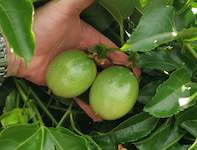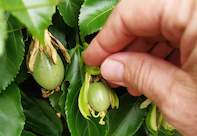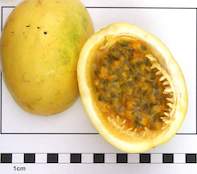Passionfruit (Passiflora edulis) a native climbing fruit native to Paraguay, Brazil and northern Argentina in South America, belongs to the Passifloraceae family. There are 500 species in this family, most of which are grown for their ornamental value because of their flamboyant flowers.

The name ‘passion fruit’ is presumably inspired by the shape of the plant’s flowers which resembled Christ's crown of thorns. It may have been invented by Spanish missionaries in South America.
Granadillas are also called maracuja.
What is a Granadilla?

The commercially viable passionfruit or granadilla is a purple or yellow-skinned aromatic fruit with a tough rind and acidic-sweet gelatinous pulp containing small edible seeds.
It is grown in warm humid areas around the world. It is a vigorous climber and needs to be trained to a sturdy support. It produces flamboyant flowers, dark green glossy leaves and if watered sufficiently, up to three harvests per year.
Most other granadillas species are ornamental with a few producing fruit that is used by birds.
Granadilla Varieties

Granadilla is a shared common name for three varieties of Passiflora: Passiflora quadrangularis (giant granadilla), Passiflora incarnata (known as maypop, purple passionflower or wild apricot) and the well-known Passiflora edulis.
The giant granadilla produces 20 - 30cm oblong yellow-green fruit with yellow to pink flesh, yellow seeds and a mild flavour. The flesh can be eaten like a melon or cooked with milk. When green, it is used as a vegetable, in similar ways to how green papaya may be used.
The yellow granadilla is more disease resistant, grows more vigorously and generally have larger fruit, 8 - 10 cm in size, with a smooth yellow rind. The yellow aromatic pulp is acidic (pH of 2.8) yet sweet with yellow seeds.
The purple granadilla has tough purple skin with orange flesh and black seeds. It is oval and measures 5 - 8 cm. The purple granadilla has less acidic pulp (pH of 4.2), a richer flavour and more juice - about 35 to 38%.
In Brazil, the purple passionfruit is preferred for consuming fresh; the yellow for juice processing and the making of preserves.
In South Africa, only the purple granadilla type - the variety ‘Ester’ - is grown. Ester is a cross between the yellow (Passiflora edulis f flavicarpa) and purple granadilla (Passiflora edulis f edulis).
South Africa’s Agricultural Research Council’s Tropical and Subtropical Crops Division (ARC-TSC) has its head office in Mbombela (former Nelspruit) with research stations in other towns. ARC-TSC breeds new granadillas and has 41 Passiflora species.
The development of new granadilla varieties focuses on disease resistance, increased yield and improved eating qualities such as fill and taste.
By Marinda Louw